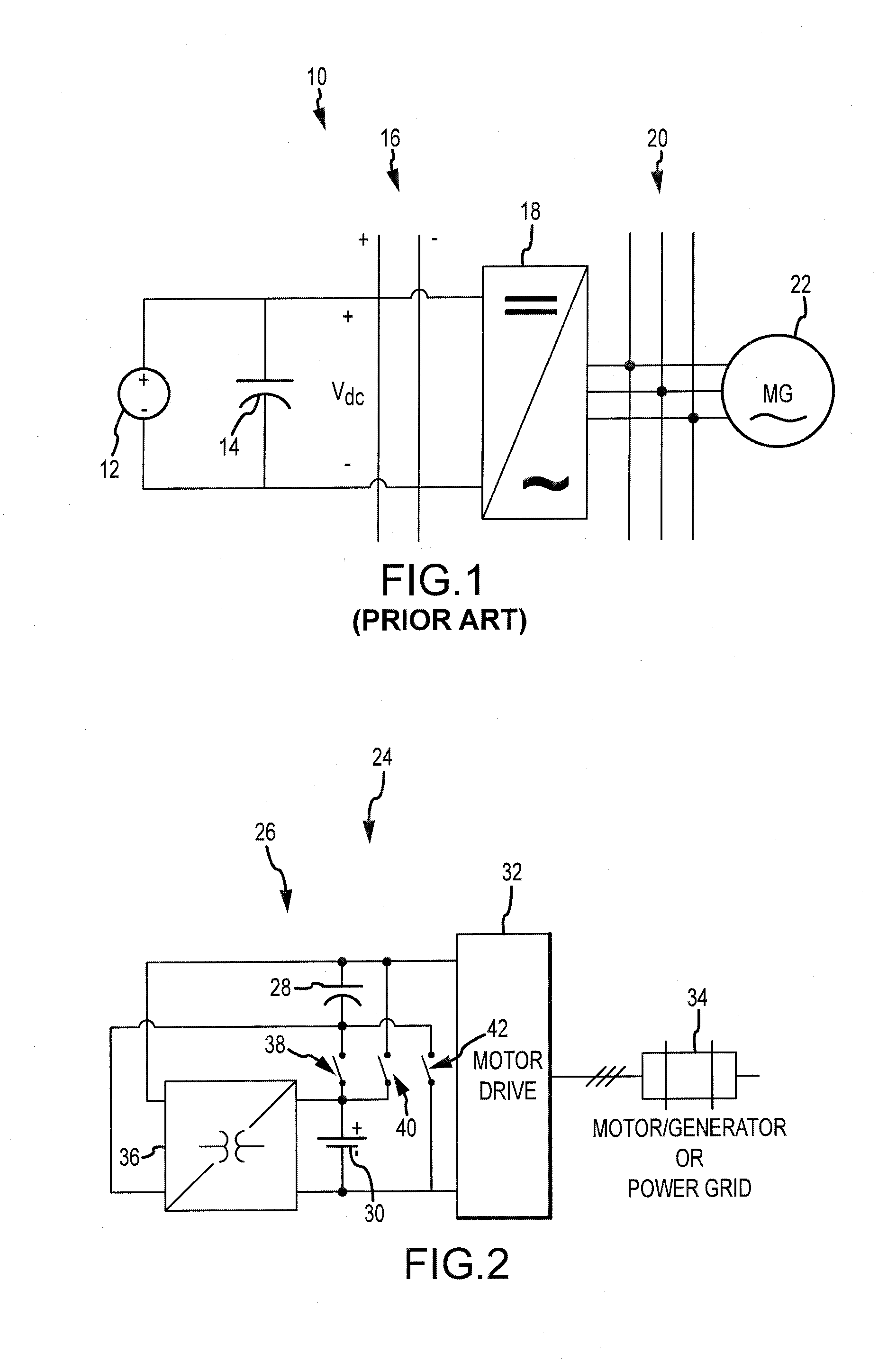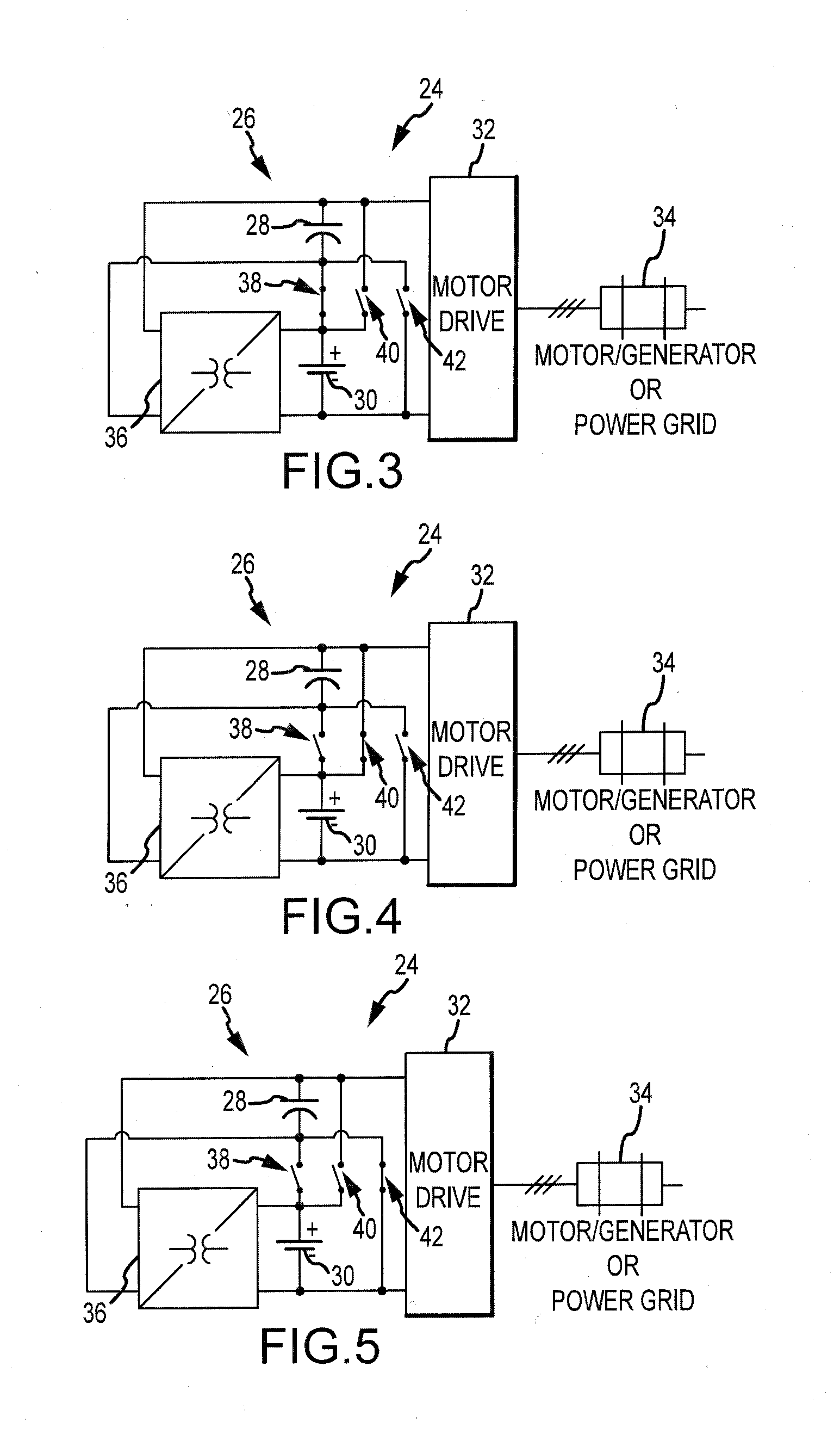Method of energy and power management in dynamic power systems with ultra-capacitors (super capacitors)
a technology of super capacitors and dynamic power systems, applied in the direction of motor/generator/converter stoppers, dynamo-electric converter control, energy-saving board measures, etc., can solve the problems of large peak power demands and regenerative power characteristics of actuators, excessive generator sizing, undesirable current and voltage transients, etc., to maximize the capture of regenerative energy, minimize main power supply size, and extend the life of energy storage elements
- Summary
- Abstract
- Description
- Claims
- Application Information
AI Technical Summary
Benefits of technology
Problems solved by technology
Method used
Image
Examples
first embodiment
[0028]FIG. 2 is a diagrammatic view generally illustrating a power management system 24 in accordance with teachings of the present disclosure. Illustrated system 24 includes a charge shuttle 26, an ultracapacitor 28, a battery 30, a motor drive 32 that is connected to the system via DC link, and a load 34. As generally illustrated, the charge shuttle 26 may include a power converter 36 and a plurality of switches 38, 40, 42. The charge shuttle 26 may also include a controller (not shown) configured to actuate switches 38, 40, 42 and to control the direction of energy flow through converter 36.
[0029]Load 34 may include, for example only, a motor / generator such as may be used in a More Electric Aircraft (MEA), Hybrid Electric Vehicle (HEV), or Plug-in Hybrid Electric Vehicle (PHEV). The motor / generator may include various components, such as regenerative and non-regenerative loads, energy sources (e.g., mechanically driven generators, fuel cells), and distribution networks. The motor...
second embodiment
[0038]FIG. 6 is a diagrammatic view of a power management system 44. The illustrated system 44 is shown including a generator 46, a main power bus 48, three AC / DC power converters 50a, 50b, 50c, three charge shuttles 26a, 26b, 26c, three ultracapacitors 28a, 28b, 28c, and a battery 30. As illustrated, each charge shuttle 26 may include a respective power converter 51 and a respective controller 53. Illustrated system 44 may further include three loads 52, 54, 56.
[0039]In the illustrated system 44, generator 46 and battery 30 are the “main” power supplies for the system 44. For example only, in a hybrid-electric vehicle (HEV) embodiment, generator 46 may be driven by the gasoline engine, and battery 30 may be the main vehicle battery or bank of batteries. Generator 46 can be configured to provide power to main power bus 48, from which system 44 draws power, as may a larger system and / or other sub-systems.
[0040]Loads 52, 54, 56 may have different characteristics. For example, load 52 ...
third embodiment
[0043]FIG. 7 is a diagrammatic view of a power management system 58. The illustrated system 58 includes is shown including two ultracapacitors 28a, 28b, two batteries 30a, 30b, a charge shuttle 26 (which includes a power converter 36 and a controller 53), a drive controller 60, and a motor / generator 62.
[0044]Drive controller 60 may be configured to control the torque applied to one or more loads of motor / generator 62. Drive controller 60 may also facilitate a field weakening current for motor / generator 62. In an embodiment (e.g., when motor / generator 62 includes a PMSM), a field weakening current may be required to produce torque at speeds above a pre-determined threshold. Such a field weakening current may be reactive and may not produce any real power except for losses in semiconductors, electrical machines, and energy sources.
[0045]In embodiments, batteries 30 and ultracapacitors 28 can serve as storage elements to store energy recaptured from motor / generator 62 for later use by ...
PUM
 Login to View More
Login to View More Abstract
Description
Claims
Application Information
 Login to View More
Login to View More - R&D
- Intellectual Property
- Life Sciences
- Materials
- Tech Scout
- Unparalleled Data Quality
- Higher Quality Content
- 60% Fewer Hallucinations
Browse by: Latest US Patents, China's latest patents, Technical Efficacy Thesaurus, Application Domain, Technology Topic, Popular Technical Reports.
© 2025 PatSnap. All rights reserved.Legal|Privacy policy|Modern Slavery Act Transparency Statement|Sitemap|About US| Contact US: help@patsnap.com



